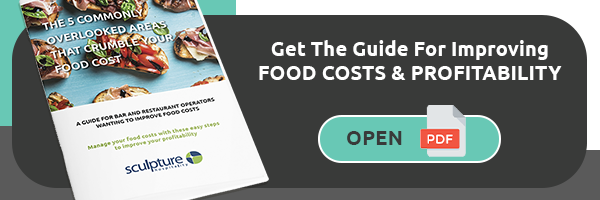It may be repetitive and time-consuming, but restaurant inventory management really is one of the most important aspects of your job as a restaurateur.
Gaining control of your inventory through effective management processes will ensure your restaurant both saves money, and becomes more profitable. Successful restaurant inventory management can lead to significant cost savings, improved visibility of business expenses, better ordering decisions and many other benefits.
The best news? It’s really not as difficult and time-consuming as you might think it is. Food and beverage inventory management tech solutions are now available to automate and improve your processes.
Using new technology and sticking to a set of best practices are the key to successful restaurant inventory management. That’s why Sculpture Hospitality has created this list of the top six restaurant inventory management best practices that your business should implement:
1 - Organize and categorize your inventory
Inventory counts are so much more difficult when your products aren’t physically organized. Separating your items by category and keeping your stock well organized on their respective shelves will help your business keep things clean. This will make it easier for your employees when they conduct inventory counts, but it will also save a significant amount of employee time each day as they won’t have to scramble around the kitchen trying to find the right ingredients.
2 - Forecast demand effectively
There’s no way your restaurant can save money during the ordering process without having a plan that ensures you are able to properly forecast demand. Your business should be able to use historical data to find valuable insights that give you an idea of what products, dishes and drinks will be popular in the future. This information on the products that are likely to sell well in the future will give you a solid idea of what (and how much) inventory you should order moving forward.
3 - Use PAR levels to improve your ordering processes
While we are on the subject of ordering, don’t forget to use the period automatic replacement (PAR) level metric to improve your ordering decisions. PAR level helps you to figure out the minimum, and optimal, level of any given inventory item that should be on-hand in your restaurant at all times - ensuring that you don’t run out of a product, but that you also don’t overstock it either.
4 - Don’t forget to measure inventory variance
It’s easy enough to count the amount of inventory you have bought with the amount of inventory you have sold, but this doesn’t give you a true indication of your restaurant’s profitability. That’s because this method doesn’t take into account variance. Successful inventory management must measure the actual amount of product you have used vs the amount of product you have sold. This will give you insights into wastage, and how your restaurant can make small changes that improve your profitability (for example, reducing overpouring or overserving).
Knowing what actually happened and what should have happened with your inventory can result is a drastic boost to your bottom line. Know your numbers before it’s too late.
5 - Use the first in, first out (FIFO) method where possible
To avoid spoilage, expiration or having a product that is no longer needed on your menu, implement a first in, first out (FIFO) inventory model. This is a way of organizing new inventory that arrives at your business in a way that ensures you use the products that arrive first - for example, placing new products behind your existing products. This ensures employees reach for the older inventory before using the newer product.
6 - Use inventory management software
Managing your inventory through manual processes can be incredibly complex and time-consuming. Thankfully, there are now innovative technologies that can help your restaurant with these processes.
Food and beverage inventory management systems can be integrated with your point-of-sale (POS) systems to track and automate all inventory management processes. These technologies will give you more visibility into your inventory management, giving you insights into where exactly you are losing money and how you can change those inefficiencies to drive profit growth.
Want to learn more about the benefits of restaurant inventory management software? Contact our team of locally-based experts today. Sculpture Hospitality has inventory management experts in all corners of the world, proving expert inventory advice and solutions to thousands of restaurants and bars.

.jpg)




.png)





.jpg?width=520&height=294&name=Copy%20of%20Sculpture%20Hospitality_Owners_August%202020%20(18).jpg)